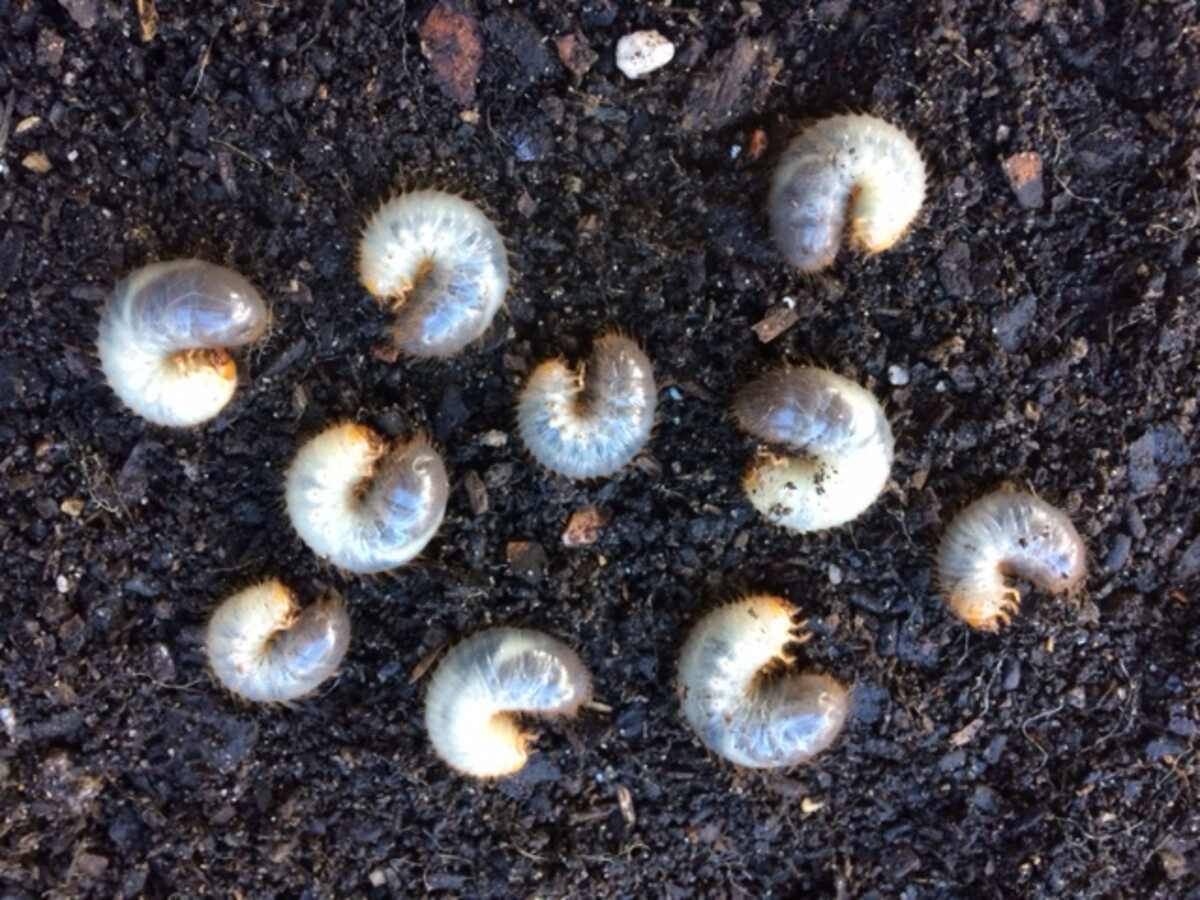
Lawn grubs — the larval stage of certain adult beetles — are common in yards across the country and do play a role in the natural order of things, but only in the right numbers. But when the populations grow out of control, you will want to know how and when to kill the grubs in your lawn.
Short on time and just want to kill some grubs? Here are our picks for the best grub killers.
What are Grubs?
A grub worm is actually not a worm, but the larval stage of an insect (like chafers and beetles). And what do grubs eat? Lawn grubs feed on the organic matter in the soil and end up munching the roots of your grass — which means trouble for your lawn.
“They’re sort of nature’s ‘de-thatchers,’” says David Shetlar, a professor emeritus with a doctoral degree in entomology at The Ohio State University. “But the problem is, [if] they’re eating that thatch, they do eat the roots and the crowns [of turfgrass], which kills the plant.” And that’s what grubs can do to your lawn: They can kill your beautiful grass.
Grubs are also bad for your garden: As larvae, they eat your plant roots, and as grown beetles, they can eat the leaves of any plant they can find.
Signs of a Lawn Grub Problem
All grass can tolerate some grub feeding, but be aware of the signs of when it gets out of control. “In many cases, grubs aren’t even discovered until the skunks and raccoons start digging them up,” said Shetlar. Look for the following signs of grubs on your lawn:
- Patches of thinning turf: Dead patches appear and grow larger each week.
- Grass will pull out very easily at the roots.
- Animals start digging in the lawn, especially moles, skunks, crows, and raccoons.
- Beetles or moths start flying around, usually low, looking for a place to lay their eggs.
- A bouncy feeling as you walk on the grass.
- Signs of drought in the grass, even though there is no drought, and there is plenty of water.
How to Scout for Lawn Grubs
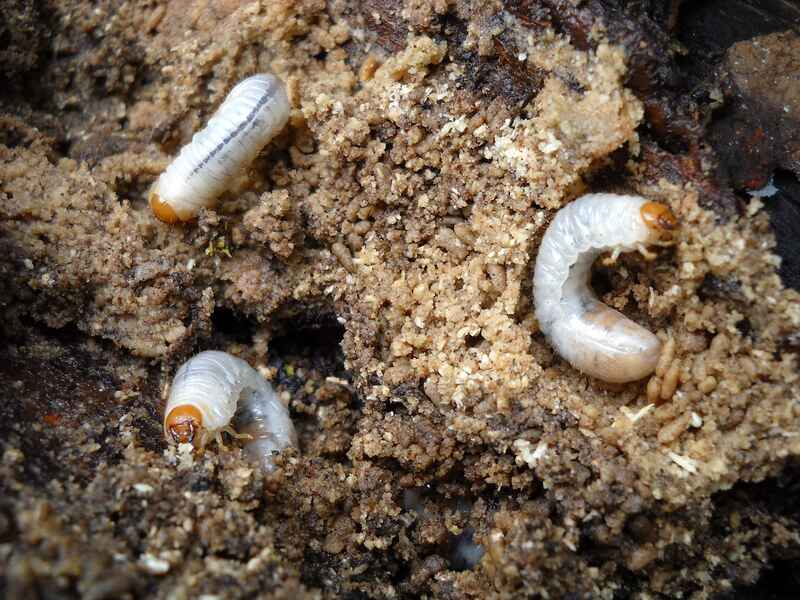
The only way to be sure that you have grubs in your lawn is to scout for them:
- Cut in a one-foot section of your lawn. You can use a shovel or a lawn edger, in a place where you suspect grub activity.
- Peel up the soil from that cut. If there is grub damage to your lawn, the grass will peel up easily.
- Sift around the soil, counting the grubs you find.
- Tally the count. If there are 10 or more grubs per square foot, you have a serious grub infestation.
- Replace the grass you’ve cut. You don’t want to damage the lawn.
- Repeat the process. Scout in other places on the lawn, just to be sure.
Getting Rid of Lawn Grubs
Now that you already know what grubs are and how to identify them, here’s how to get rid of lawn grubs in two ways:
- With preventative methods
- And curative methods
Preventative

When it comes to lawn grubs, prevention is key. Follow these tips on how to get rid of grubs in your lawn by preventing them in the first place:
- Dethatching is key. “I emphasize a lot — especially to lawn care and sport field managers — [to try] to keep the thatch down to a minimum,” Shetlar said. His key to this: fertilizing one’s lawn with nitrogen only once per year, and doing it very strategically “and judiciously, usually in late October, early November.”
- Aerate your lawn. As grubs feed on the thatch of compacted soil, aerating can help prevent grubs from installing by breaking the thatch layer of the lawn, while also encouraging root growth.
- Think before you mow. Keep your lawn properly mowed. For efficient grub control for your lawn, use a mower’s highest setting, which can be 3.5 to 4 inches. This will produce a deeper, therefore stronger, root system. If you mow high and use fertilizer in the spring, you might not need to apply a grub killer on your lawn.
- Choose the right turfgrass. Daniel. A. Potter, an entomologist at the University of Kentucky, “has conclusively shown that the tall [fescue grasses] are much more tolerant of grub populations,” says Shetlar.
“Where Kentucky bluegrass and perennial ryegrass will be damaged with … eight to 10 grubs per square foot, the tall fescues usually require somewhere around 12 to 14 grubs per square foot” before showing damage.
- Deny moisture to the grubs. Keep your lawn dry during July and August, something that will cause beetle eggs to dry and die. If your lawn starts to brown, you can water more; there will be no residual damage.
- Turn to chemical insecticides. Effective preventive grub treatments for lawns include imidacloprid, thiamethoxam, and clothianidin. The best time to apply these pesticides runs from the middle of April to the middle of June, depending on where you live. If you wait until brown patches appear, it is too late.
Note: Any use of insecticides poses a risk of harm not only to people, but other insects, including lawn-beneficial pollinators. One way to mitigate the damage: Mow your lawn just before applying so there are no weed flower heads to attract pollinators to your temporarily poisoned yard.
Curative
But what if you’re dealing with an active grub infestation? Another side of lawn grub control comes into action: the curative methods. These are ways you can deal with active infestations. Here’s how you can treat the grubs in your lawn:
- Curative chemical insecticides. Carbaryl and trichlorfon are considered curative treatments. You apply them once you’ve noticed grubs in the grass. They are short-lived products that are effective immediately. Treated grubs turn yellow or brown within a week, so reevaluate the turf the week after that to see if the chemicals have succeeded.
- Milky spore disease. Another grub treatment for your lawn is to fight grubs with milky spore disease. “The commercial milky spore disease is only for Japanese beetles,” Shetlar says. “Even then, milky spore disease is a weak pathogen that results in 20% to 25% infection at best.”
- Neem oil is your ally. Neem oil is an effective pesticide against grubs while also being safe for pollinators. For a DIY solution, mix neem oil and water according to label instructions. Spray your yard with the solution using a pump sprayer or a hose-end sprayer. Apply in late summer or early fall.
- Turn to natural enemies. Naturally occurring pathogens (fungi, bacteria, protozoa) kill or weaken grubs; they already exist in the soil, but chemicals you apply will kill them, so you might want to hold off any other chemical grub treatment and let the pathogens do their work.
Ground beetles and ants are beneficial insects that feed on eggs and young grubs. Parasitic wasps and flies go after older grubs.
- Consider beneficial nematodes. Shetlar says, “There’s a very steep learning curve to using the insect parasitic nematodes.” They can only be effective as a lawn grub treatment when used curatively, and even then, only on small affected areas.
However, Shetlar did let on that the most experienced organic lawn care professionals may have the knack for using beneficial nematodes as an effective lawn grub killer. “In that case, they work quite well,” he said. “You can typically get 60% to 100% control with the nematodes when they’re used at the right time in the right way.”
When to Treat Your Lawn for Grubs
The best time to apply preventative grub control products is from mid-April to mid-June, or as a general rule, in summer or early fall, when the eggs have not hatched yet or the grubs are still small. If you missed this time window, apply a curative treatment for grubs into the lawn as soon as the first signs of grub damage begin to appear.
When to Call Pest Control Pros
If in doing the tally, you find more than six grubs per square foot, it’s a good time to take action and treat your lawn for grubs. Don’t wait until you have a serious infestation.
“I always chuckle about [checking the threshold], in that skunks and raccoons haven’t read about this threshold,” says Shetlar. “If there are four to five grubs per square foot, that’s usually enough for them to be digging around.”
It might also be enough for you to call in your local lawn pest control professionals so they can do the grub worm killing to avoid further damage to your lawn.
Life Cycle of Lawn Grubs
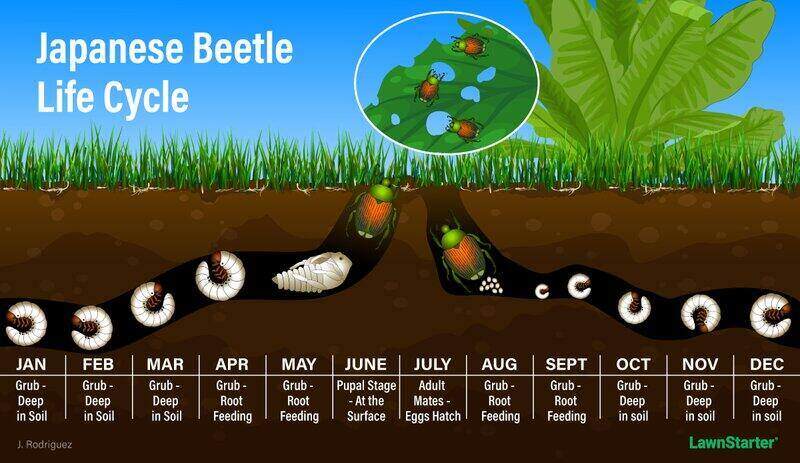
Just as babies don’t come from a stork carrying them in a basket, grubs also don’t come from the heavens. So where do grubs come from? Here is the life cycle of lawn grubs:
- In summer, insects lay eggs. European chafers do this in late June, Japanese beetles in July and August.
- One to two weeks later, the eggs hatch, and the young grubs begin feeding on roots of grass.
- July and August are when grub eggs die off. Because of the dry soils, the eggs die from moisture stress.
- Until fall, the grubs in your yard feed and then burrow deep into the soil.
- In winter, grubs are burrowed deep, overwintering in the lawn.
- In spring, grubs burrow upwards to grass roots and resume feeding.
Lawn Grubs: What They Look Like
If you’ve never seen grass grubs before, this is what they look like:
- White grubs are similar in appearance but may differ in size.
- Size varies with the species, but when fully developed, adult grubs can range from 3/8 inch to nearly 2 inches in length.
- Grubs are cream-colored with a brown head. They have three pairs of short legs.
- Soft bodies that are usually curled into a C shape.
- Adult beetles are oval in shape. They can be green, tan, brown, or black and can range from 3/16 of an inch to 1 inch in length.
- Most species aren’t noticed because they are active at night. Often they are seen only when attracted to outdoor lights.
Kinds of Lawn Grubs: They All Do the Same Damage
“It’s irrelevant which species it is,” says Shetlar. “They cause the same kind of damage.” But here are the kinds of lawn grubs you are likely to find right outside your door:
- Japanese beetle grubs are widespread invasive insects, and their white grub larvae are found in lawns all over the country. Japanese beetles can be seen mating at their feeding sites during the day.
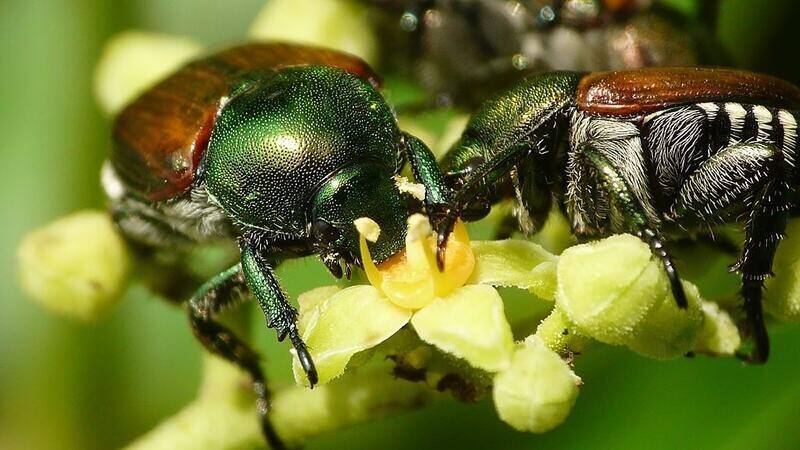
Photo Credit: coniferconifer / Wikimedia Commons / CC BY 2.0
- Asiatic garden beetles are light brown as adults and white with a brown head as grubs (similar to other white grubs). There are signs they are overtaking the Japanese beetle in some areas of the eastern U.S. The Asiatic garden beetles are nocturnal and will come to lights at night.
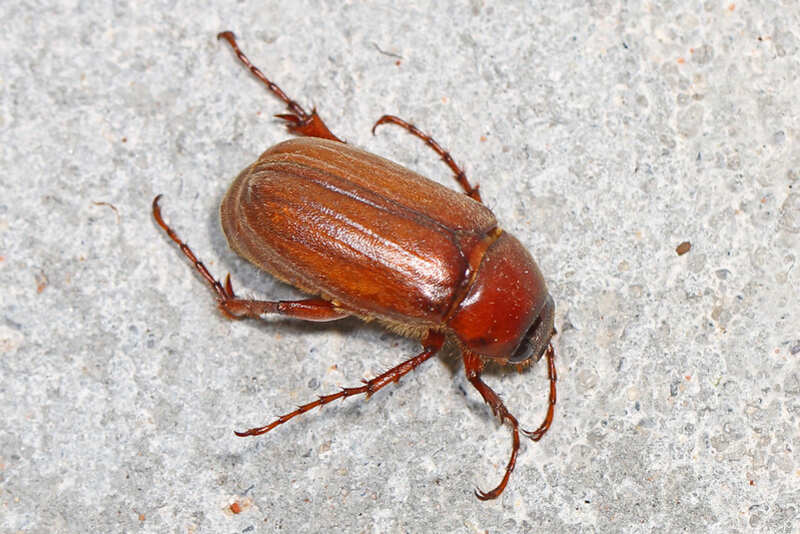
Photo Credit: Judy Gallagher / Flickr / CC BY 2.0
- Chafer species, led by the masked chafer beetles (such as the European chafer) also lead to white grub infestations. European chafers conduct mating flights at dusk near trees or chimneys.
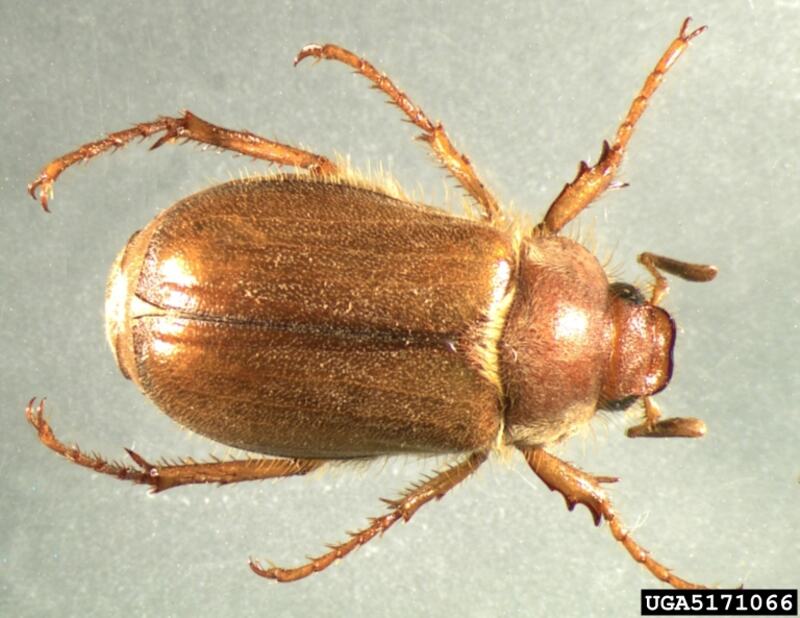
Photo Credit: Mike Reding & Betsy Anderson, USDA Agricultural Research Service / Wikimedia Commons / Public Domain
- May beetles: Also known as June bugs, they are members of a large family of beetles called scarabs.
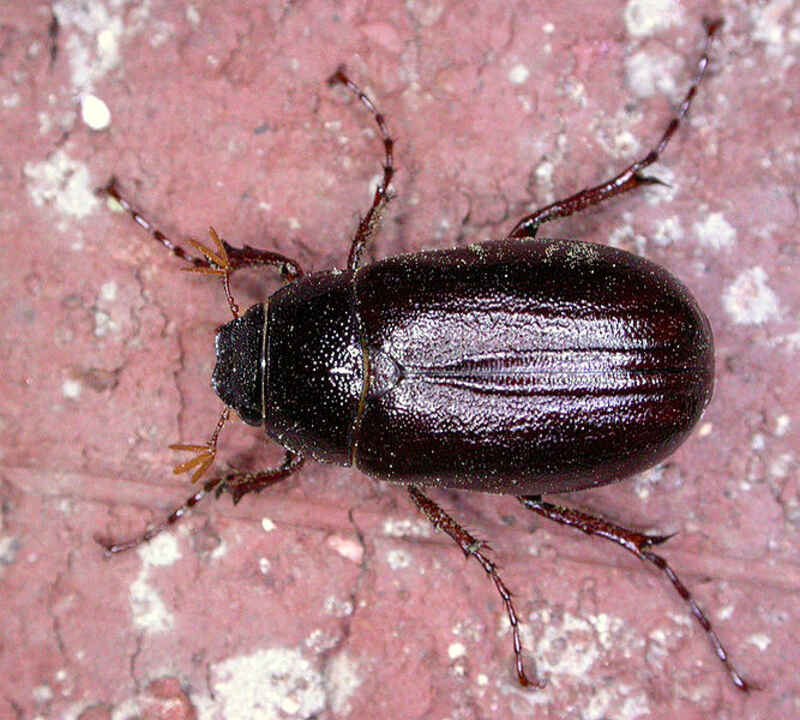
Photo Credit: Patrick Coin / Wikimedia Commons / CC BY-SA 2.5
- Black turfgrass ataenius: This shiny black adult beetle can be found in turfgrass but is mostly found on golf courses.
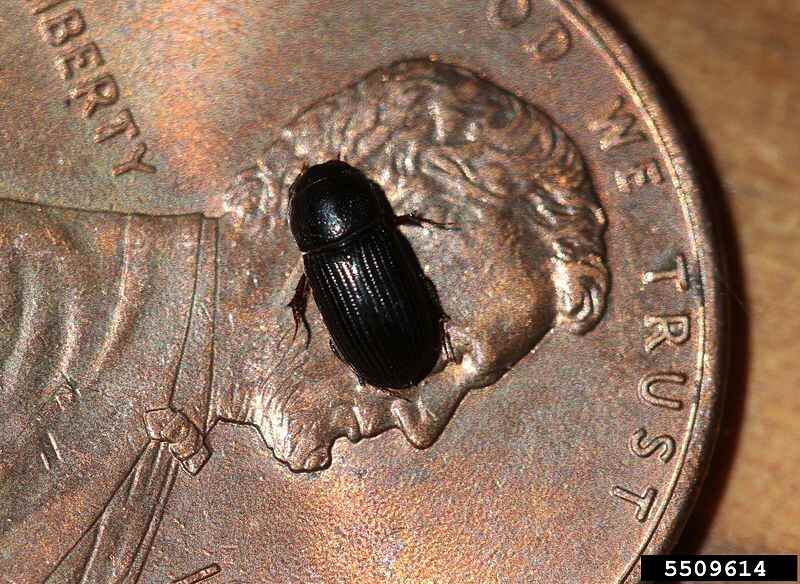
Photo Credit: Whitney Cranshaw, Colorado State University, Bugwood.org / Wikimedia Commons / CC BY 3.0
FAQ
Don’t Lawn Grubs Play a Positive Part in a Lawn’s Ecosystem?
Yes, but they can also be destructive. “Everybody says grubs eat the grass roots,” says Shetlar, professor emeritus at The Ohio State University, but there’s more to them than that. “White grubs are eating the accumulated thatch and organic matter that’s in the top inch of the soil profile.”
“They’re sort of nature’s ‘de-thatchers,’” he added. “But the problem is, [if] they’re eating that thatch, they do eat the roots and the crowns [of turfgrass], which kills the plant.” It’s when these “de-thatcher” populations grow out of control that the grubs end up killing your grass and the dreaded lawn damage takes place.
Is Lawn Damage a Sure Sign of Lawn Grubs?
Many lawn issues that resemble grub damage can be caused by something else:
• Soil compaction
• Disease
• Drought stress
• Hairy chinch bugs
• Sod webworms
• Shade
In the early spring, many homeowners suspect grub damage because of the condition of their lawn after snow melt.
How Can I Predict if my Lawn Will Have Grub Damage This Year?
Lots of adult beetles on the lawn in July is one indication. Watch lawns closely starting in the middle of August and continuing into September for wilting and browning areas.
Does the Browning of a Lawn Mean There Are Grubs?
Since grubs eat grass roots, the lawn will be easy to pull up in chunks. If it’s still firmly rooted, then you have another problem, such as brown patch.
Why Are There Bright Green Rings Around Those Brown Spots?
If strange brown spots show up on your lawn with something even stranger, a bright green grass ring, you might check for dogs. Dog urine does just this kind of damage.
No Time to Wait
Don’t wait for lawn grubs to destroy your lawn. Take action before you see them by taking care in selecting your grass and caring for it. If you still get them, don’t wait. Be willing to call in lawn pest professionals, especially if considering chemical lawn grub treatments.
For year-round lawn care maintenance, call a LawnStarter pro to keep your grass strong and healthy (and better able to resist grub damage) all growing season long.
LawnStarter participates in the Amazon Services LLC Associates Program, an affiliate advertising program. LawnStarter may earn revenue from products promoted in this article.
Main Image Credit: Anna Gregory / Flickr / CC BY 2.0